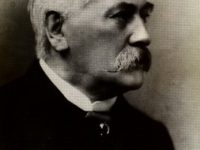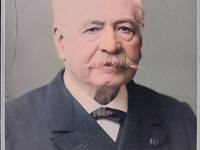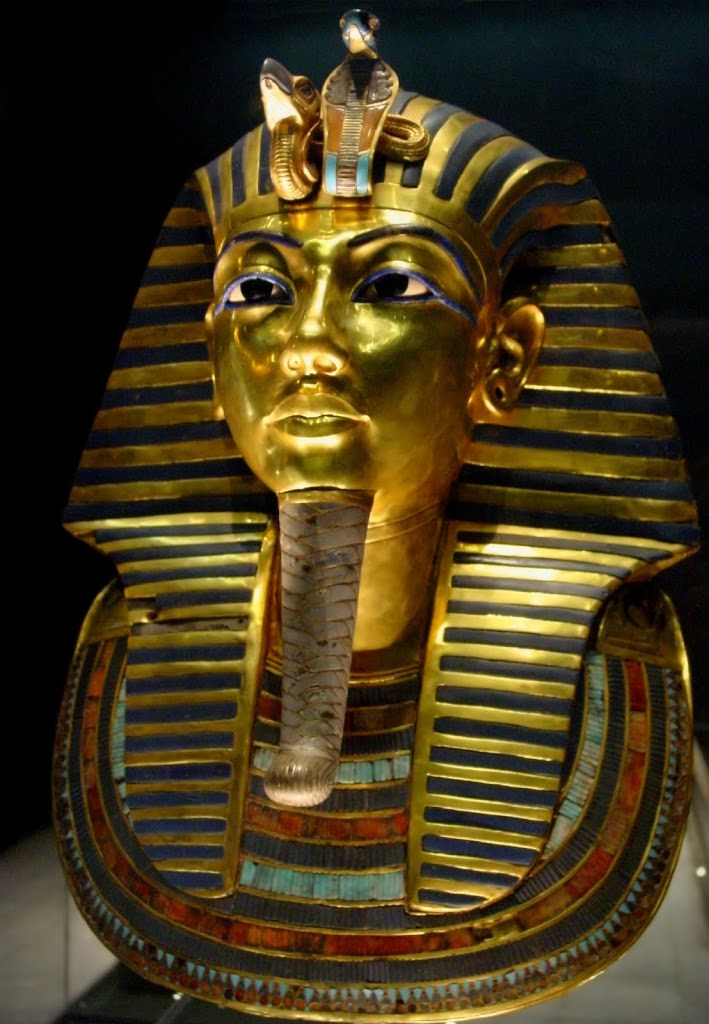
Tutankhamun’s famous burial mask, photo: Bjørn Christian Tørrissen, CC BY-SA 3.0, via Wikimedia Commons
On November 26, 1922, Archeologist Howard Carter together with the 5th Earl of Carnarvon, opened the unharmed tomb of pharao Tutankhamun, one of the most important archeological discoveries of the 20th century.
From Tutankhaten to Tutankhamun
King Tut, as the Egyptian pharaoh of the ‘New Kingdom’ was called in popular culture, ruled between 1332 BC and 1323 BC. When the prince, back then called Tutankhaten became king, he was only ten years old. Nevertheless he already brought many changes to his people against his father’s wishes, Akhenaten (formerly Amenhotep IV), who had replaced the traditional religion. Akhenaten is noted for abandoning traditional Egyptian polytheism and introducing worship centered on the Aten, which is sometimes described as monolatristic, henotheistic, or even quasi-monotheistic. An early inscription likens the Aten to the sun as compared to stars, and later official language avoids calling the Aten a god, giving the solar deity a status above mere gods.
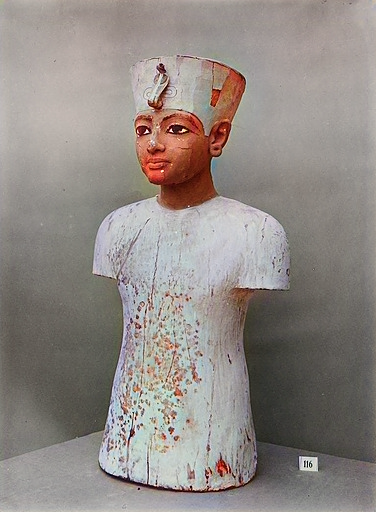
A painted, wooden figure of Tutankhamun found in his royal tomb
Tutankhaten restored the worship of the god Amun. The ban on the cult of Amun was lifted and traditional privileges were restored to its priesthood. The most significant evidence of the policy carried out under Tutankhamun is his later usurped stele of restoration found in Karnak by Haremhab. On it the decay of the empire under Aton is described and he proclaims the return to the ancient gods. Throughout the country, the young Pharaoh had the temples of the ancient gods restored. The Egyptian capital was moved back to Memphis and the city of Akhetaten abandoned. This is when he changed his name to Tutankhamun, “Living image of Amun“, reinforcing the restoration of Amun, as an illustration of dissociation from his father’s ideals and politics. But unfortunately, the king was not allowed to reign more than nine years since he died at the age of 19 under unclear circumstances. It was widely known that he suffered many health issues but the actual reason for his death is unknown up to this date even though scientists from all over the world have researched for several decades now.[7]
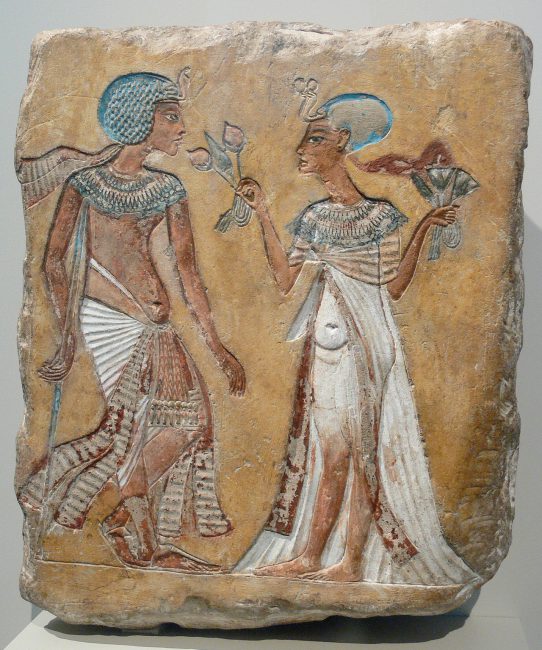
Limestone relief “Walk in the garden” with a representation of Tutankhamun with walking stick and Anchesenamun, Neues Museum Berlin
The Discovery of the Tomb
The story of Tuthankamen’s tomb discovery began already in 1907. Theodore M. Davis had just discovered the tomb of the pharaoh Horemheb, who depicted the last one of the 18th dynasty and therefore ruled after Tutankhamun. However, Davis also discovered several artifacts with king Tut’s name and assumed to have found his entire tomb. It was about one decade later, when the experienced Howard Carter, Egyptologist and archeologist was given the task to perfom several excavations by Lord Carnarvon. When Howard Carter discovered the tomb in the Valley of the Kings in 1922, the news spread around the world and sparked great interest, which did not fade for a long time. The first thing found by a crew member was a step leading to another and another. The team was excited and called for Carnarvon, who instantly came and made his way together with Carter through a door into an empty room. Knowing that there must be a secret door, Carter managed to find it and revealed a chamber filled with treasures, statues and most important, Tutankhamun’s tomb. Carter’s first impressions were stated as following:
“As my eyes grew accustomed to the light, details of the room within emerged slowly from the mist, strange animals, statues and gold – everywhere the glint of gold…I was struck dumb with amazement, and when Lord Carnarvon, unable to stand the suspense any longer, inquired anxiously, ‘Can you see anything?’ it was all I could do to get out the words, “Yes, wonderful things.”
The tomb was seen by the Carter and his employer for the first time in 3000 years and also the pharaoh’s sarcophagus was opened with only one journalist allowed to participate. It then took eight years from the date of its discovery to remove carefully all objects from the tomb for investigations and exhibitions. The tomb remains the most famous of all times due to the fact that its contents were held almost perfectly intact for 3000 years.
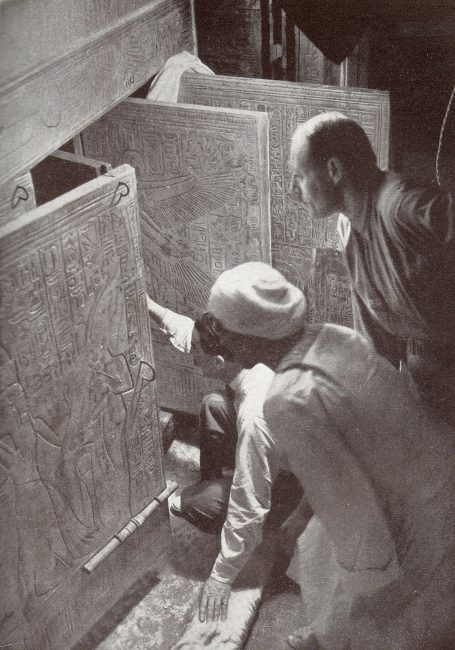
Howard Carter (squatting), Arthur Callender and an Egyptian workman, looking into the opened shrines enclosing Tutankhamun’s sarcophagus in 1924.
The main finds from the tomb, including the golden death mask, are in the Egyptian Museum in Cairo and in magazines in Cairo and Luxor. The Pharaoh’s mummy is the only one of an Egyptian king that, after the discovery and opening of the tomb, is still in its original burial place in the Valley of the Kings. I
The Curse of the Pharaos
In connection with the excavation work and the lively interest of the world press, the legend of the Pharaoh’s curse spread after the discovery of the trench. Much was said about the curse of the mummy, which allegedly met the discoverers. Some members of Carter’s excavation team died within the first five years of the sarcophagus being excavated, including the financier of the KV62 excavations, Lord Carnarvon, who died of infection on April 5, 1923.
The causes of the deaths were investigated: Five members of the discovery team committed suicide on the basis of the publications of the other deaths. Infections by mould spores in the air of the burial chamber or mosquito bites were seen as other causes. Diseases already present at the opening of the grave also led to death, which would have occurred even without a connection to the grave. Statistical investigations even revealed an increased average age of all alleged victims.
Nicholas Reeves, Recent Research in Egyptian Art: Behind the Mask of Tutankhamun, [9]
References and Further Reading:
- [1] Tutankhamun’s tomb at the Theban Mapping Project
- [2] Pictures of the excavation at The Griffith Institute Website
- [3] The Last Survivor at Saudi Aramco World
- [4] Grim Secrets of Pharaoh’s City at BBC
- [5] Tutankhamun’s Official Website
- [6] Howard Carter and the Tomb of Tutankhamun, SciHi Blog
- [7] The CT Scan of Tutankhamun, SciHi Blog
- [8] Howard Carter at Wikidata
- [9] Nicholas Reeves, Recent Research in Egyptian Art: Behind the Mask of Tutankhamun, Nicholas Reeves, Sylvan C. Coleman and Pamela Coleman Memorial Fellow, Department of Egyptian Art, The Metropolitan Museum of Art , The Met @ youtube
- [10] James, T. G. H. (2000). Howard Carter: The Path to Tutankhamun, Second Edition. I. B. Tauris.
- [11] Brier, Bob (2022). Tutankhamun and the Tomb that Changed the World. Oxford University Press.
- [12] Winstone, H. V. F. (2006). Howard Carter and the Discovery of the Tomb of Tutankhamun, Revised Edition. Barzan Publishing
- [13] Timeline of Egyptian pharaos, via Wikidata

